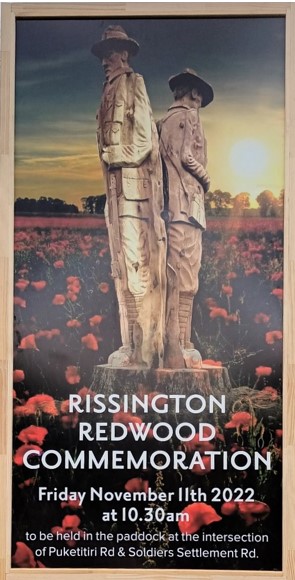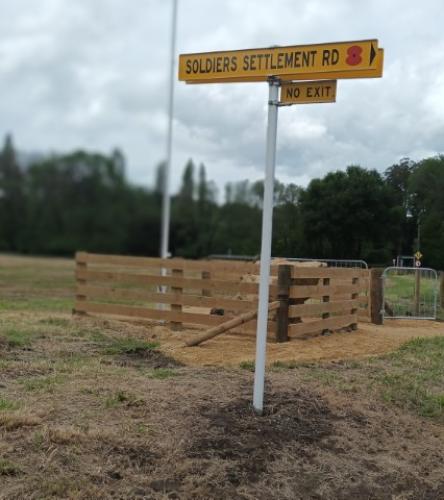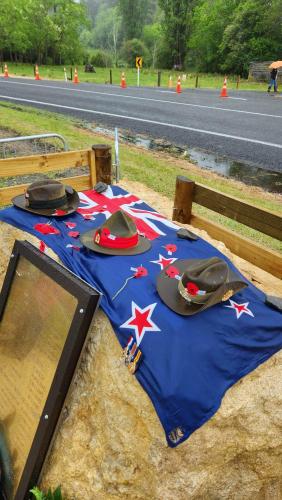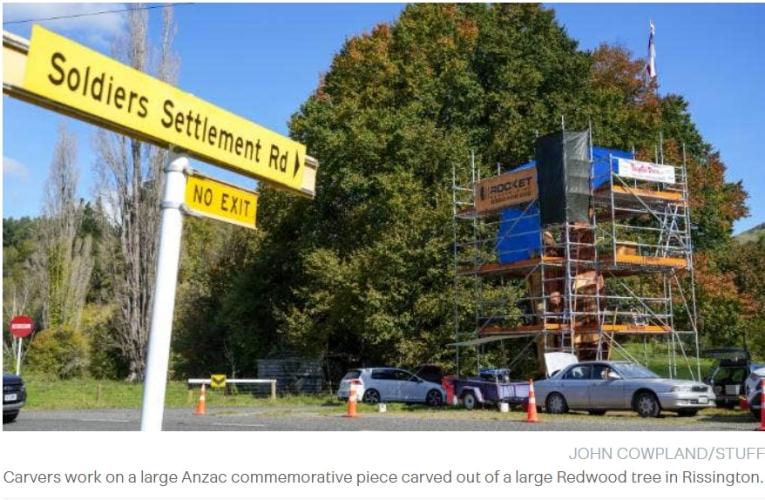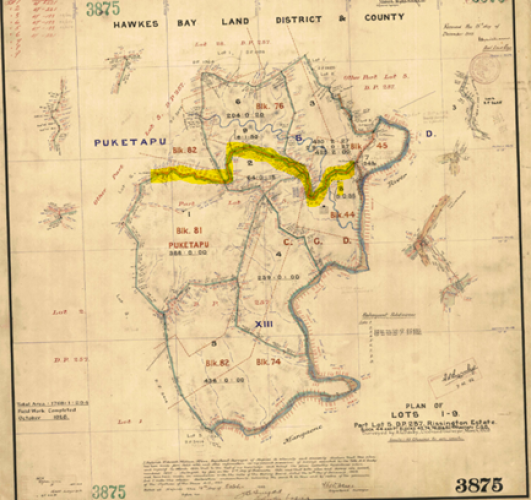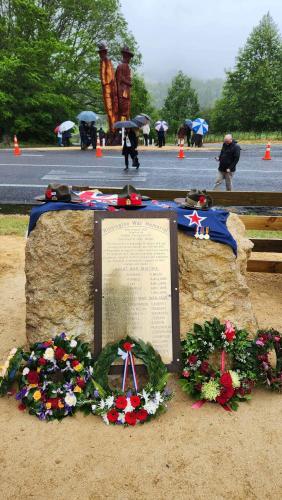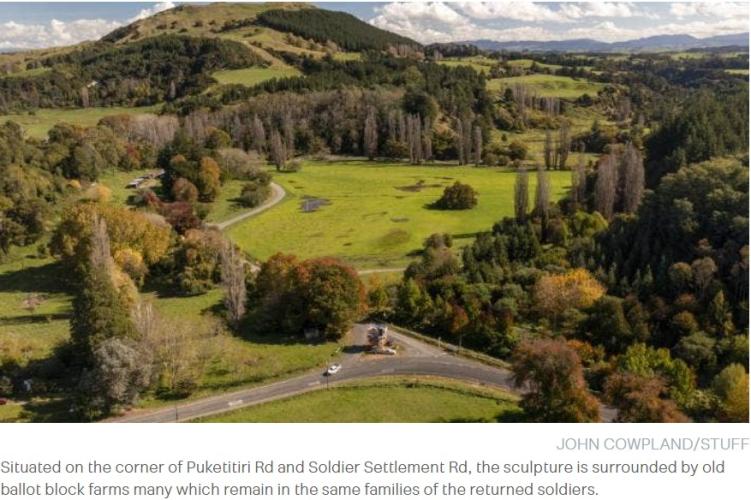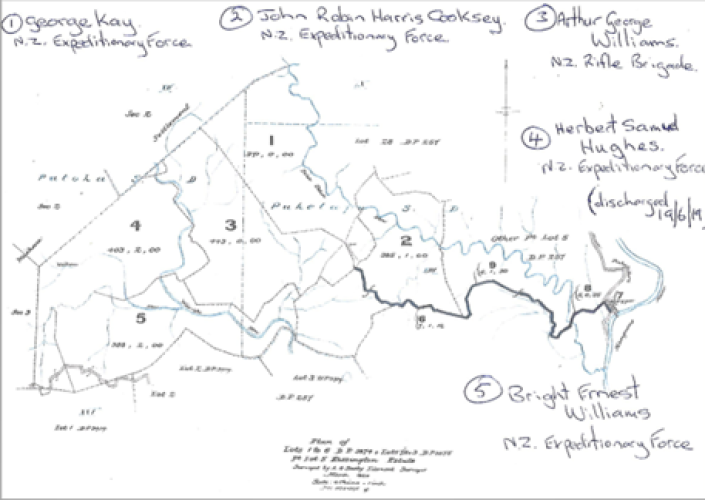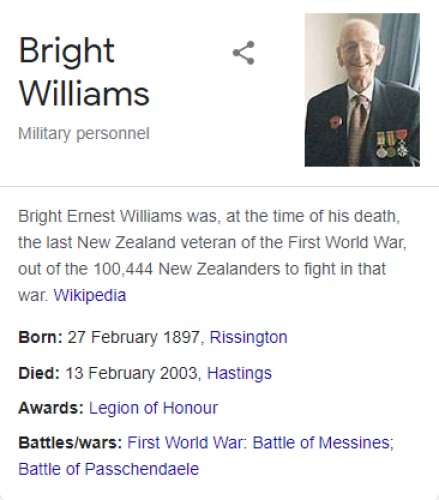Soldiers Settlement Road Aerial View
Reason for the name
The land at the time the road was named was within the Hawkes Bay County Council (HBCC) jurisdiction. Records for the HBCC were destroyed in the fire after the 1931 earthquake. It is believed the road was named circa 1920 at approximately the time when the allotments for the soldier’s ballot were created.
In 1919, five farms were subdivided from the Rissington Station area and made available to the Government for Returned Servicemen who had, previous to their service in the forces, worked in Rissington. In 1920 farm staff extended the farm road past the original station woolshed, to give access to the returned soldiers who has been allocated land under the World War One resettlement programme. Thus did the Soldiers Settlement Road come into being.
In 1919 five farms were subdivided from the Rissington Station area and made available to the Government, for Returned Servicemen who had previous to their service in the forces, worked in Rissington as fencers, shearers, scrub cutters, general farm hands, and so on.
For many years there had been a farm road past the original Rissington homestead to the station woolshed. In 1920, the station staff extended this road to give access to the returned Soldiers who has been allocated land under the World War One resettlement programme. Thus did the Soldiers Settlement Road come into being with the farms being balloted to J.R.H. Cooksey, Arthur Williams, and George Kay –serviced by the Soldiers Settlement Road, with Bright Williams and Bert Hughes having access from the Dartmoor side.
There is none of the original ballot receiver’s family farming these blocks today, but their history lives on with locals remembering their presence here.
Ballot 1 George Kay Gunner NZ Field Artillery
Ballot 2 John Robin Harris Cooksey Wellington Mounted Rifles
Ballot 3 Arthur George Williams NZ Rifle Brigade
Ballot 4 Herbert Samuel Hughes NZ Field Artillery
Ballot 5 Bright Ernest Williams NZ Rifle Brigade
All the men were part of the New Zealand Expeditionary Force.
The Discharged Soldiers Settlement Act of 1915 marked the adoption of a major scheme for settling returned soldiers on the land. Crown land as well as private land bought by the Crown was subdivided and loans were granted for development and for the purchase of existing properties.
Nine thousand five hundred men were financed onto farms, 4,000 following subdivisions of 1·4 million acres by the Crown and 5,500 by the purchase of existing properties totalling 1·2 million acres. High post-war produce prices and the heavy demand for land forced prices up.
The Crown paid £6 million for the 305 estates it purchased for soldier settlement and advanced another £9 million to finance men into existing farms. Substantial areas changed hands reaching a peak in 1921 when 4½ million acres were sold in 55,746 transactions for consideration of £818 million.
Once produce prices fell, the new settlers, many of them with little or no farming experience, found themselves in financial difficulties. Some abandoned their farms and more than 5,000 applied to have their properties revalued by a Revaluation Board set up in 1923. As a result, £29 million was written off capital values of leases and mortgage principal.
Arthur George Kay - regiment number 17195
Gunner 16th Reinforcements, New Zealand Field Artillery, New Zealand Expeditionary Force
Born 15/10/1883 Died 25/10/1949
Arthur enlisted in the army on 26/08/1918 at the age of 32, his occupation was labourer and his last address was Patoka.
He served in France during 1917 and 1918. On 26/08/1918 a shell exploded nearby. Arthur was diagnosed with shell concussion and had hearing loss due to the explosion. Arthur was admitted to hospital and also spent some time in a convalescent hospital. He had been diagnosed as needing rest and freedom from explosive sound. He was discharged from the army on 26/5//1919 after serving a total of 2 years and 335 days.
John Robin Harris Cooksey - regiment number 11/652
Wellington Mounted Rifles – New Zealand Expeditionary Force
Born 23/11/1889 Died 31/5/1975
John enlisted in the army on 12/8/1914 at the age of 25, his occupation was a sheep farmer and his last address was Rissington.
John had previously spent 2 years in the British armed forces from 1909-1911 and his reason for leaving was to travel abroad.
His rank on enlistment was Lance Corporal. During 1914, 1915 & 1916 John spent some time in Egypt.
He served in the Balkans (Gallipoli) in 1915 and in France in 1916, 1917, and 1918.
John had attained the rank of 2nd Lieutenant by the time he was discharged on 12/4/1919 after serving a total of 4 years and 245 days.
Arthur George Williams - regiment number 20268
Rifleman 10th Reinforcements, 2nd Battalion, F Company New Zealand Rifle Brigade
Born 17/2/1879 – Died 4/10/1958
Arthur enlisted in the army on 1/5/1916 at the age of 36, his occupation was a carrier and his last address was Rissington.
He served in France and was wounded while on duty on 12/9/1917 and appears to have stayed with his unit. He was next reported as wounded and admitted to the Casualty Clearing Station on 8/9/1918, he was admitted to hospital on 10/9/1918 and returned to England on 19/9/1918. On 23/9/1918 he was admitted to the NZ General Hospital. On 8/12/1918 Arthur embarked on the “Ruahine” and returned to New Zealand.
A Medical Board convened on 26/3/1919 and determined that Arthur was suffering from emphysema and chronic pulmonary disease and this was attributed to being the result of active service. The board recommended that he be considered for a pension.
Arthur was discharged from duty on 9/4/1919 after serving a total of 2 years 156 days.
Herbert Samuel Hughes - regiment number 11/2129
Trooper 9th Reinforcements, Wellington Mounted Rifles, B Squadron, New Zealand Expeditionary Force
Born 19/3/1894 - Died 20/10/1982
Herbert enlisted in the army on 12/10/1915 at the age of 22 years, his occupation was an engine driver and his last address was Ahuriri.
In 1916 he spent time in Egypt. He served in France during 1916, 1917 and 1918
Apart from being admitted to Tauherenikau hospital in the Wairarapa on 12/11/1915 due to influenza, he has not had any further medical issues recorded.
Herbert was discharged from duty on 7/6/1919 after attaining the rank of Driver and serving a total of 3 years 239 days.
Bright Ernest Williams - regiment number 14896
Rifleman NZ Rifle Brigade – New Zealand Expeditionary Force
Born 27/2/1895 – 13/2/2003
Bright enlisted on 6/3/1916 at the age of 21, his occupation was a labourer and his last address was Rissington.
Bright served in France between 1916 and 1917. He was wounded in action on 12/10/1917. On 14/7/1917 he was picked up by a field ambulance and taken to a Casualty Clearing Station. On 16/10/1917 he was admitted to hospital for a gunshot wound to his left thigh. It was a serious wound that resulted in considerable loss of muscle tissue.
A medical board found him to be unfit for duty on 27/11/1917.
On 17/1/1917 Bright was promoted to Lance Corporal, on 26/5/1917 the appointment of Lance Corporal was relinquished at his own request.
Bright was discharged on 19/3/1918 after serving a total of 2 years 13 days.
Authors
Bronwyn Farquharson.
Helen Gelletly, Hastings District Council


